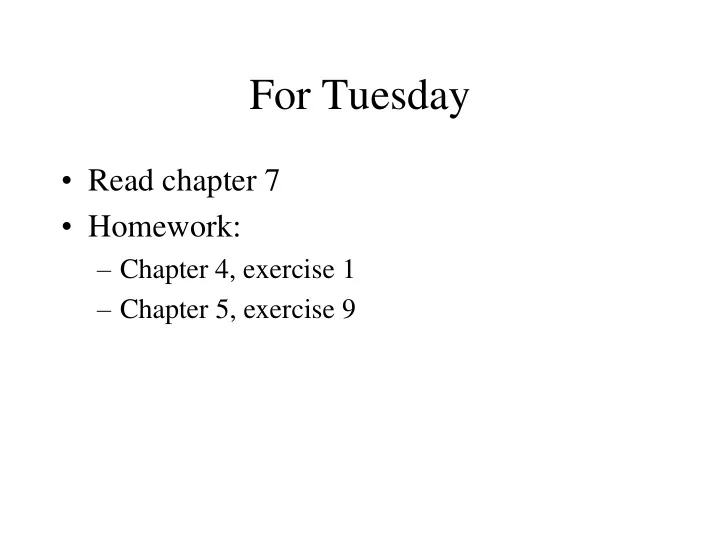

For Tuesday • Read chapter 7 • Homework: – Chapter 4, exercise 1 – Chapter 5, exercise 9
Program 1 • Any questions?
Discussion Assignment
Local Beam Search • Variant of hill-climbing where multiple states and successors are maintained
Genetic Algorithms • Have a population of k states (or individuals ) • Have a fitness function that evaluates the states • Create new individuals by randomly selecting pairs and mating them using a randomly selected crossover point . • More fit individuals are selected with higher probability. • Apply random mutation . • Keep top k individuals for next generation.
Game Playing in AI • Long history • Games are well-defined problems usually considered to require intelligence to play well • Introduces uncertainty (can’t know opponent’s moves in advance)
Games and Search • Search spaces can be very large: • Chess – Branching factor: 35 – Depth: 50 moves per player – Search tree: 35 100 nodes (~10 40 legal positions) • Humans don’t seem to do much explicit search • Good test domain for search methods and pruning methods
Game Playing Problem • Instance of general search problem • States where game has ended are terminal states • A utility function (or payoff function) determines the value of the terminal states • In 2 player games, MAX tries to maximize the payoff and MIN is tries to minimize the payoff • In the search tree, the first layer is a move by MAX and the next a move by MIN, etc. • Each layer is called a ply
Minimax Algorithm • Method for determining the optimal move • Generate the entire search tree • Compute the utility of each node moving upward in the tree as follows: – At each MAX node, pick the move with maximum utility – At each MIN node, pick the move with minimum utility (assume opponent plays optimally) – At the root, the optimal move is determined
Recursive Minimax Algorithm function Minimax-Decision( game ) returns an operator for each op in Operators[ game ] do Value[ op ] <- Mimimax-Value(Apply( op , game ), game ) end return the op with the highest Value[ op ] function Minimax-Value( state , game ) returns a utility value if Terminal-Test[ game ]( state ) then return Utility[ game ]( state ) else if MAX is to move in state then return highest Minimax-Value of Successors( state ) else return lowest Minimax-Value of Successors( state )
Making Imperfect Decisions • Generating the complete game tree is intractable for most games • Alternative: – Cut off search – Apply some heuristic evaluation function to determine the quality of the nodes at the cutoff
Evaluation Functions • Evaluation function needs to – Agree with the utility function on terminal states – Be quick to evaluate – Accurately reflect chances of winning • Example: material value of chess pieces • Evaluation functions are usually weighted linear functions
Cutting Off Search • Search to uniform depth • Use iterative deepening to search as deep as time allows (anytime algorithm) • Issues – quiescence needed – horizon problem
Alpha-Beta Pruning • Concept: Avoid looking at subtrees that won’t affect the outcome • Once a subtree is known to be worse than the current best option, don’t consider it further
General Principle • If a node has value n, but the player considering moving to that node has a better choice either at the node’s parent or at some higher node in the tree, that node will never be chosen. • Keep track of MAX’s best choice ( ) and MIN’s best choice ( ) and prune any subtree as soon as it is known to be worse than the current or value
function Max-Value (state, game, , ) returns the minimax value of state if Cutoff-Test(state) then return Eval(state) for each s in Successors(state) do <- Max( , Min-Value(s , game, , )) if >= then return end return function Min-Value(state, game, , ) returns the minimax value of state if Cutoff-Test(state) then return Eval(state) for each s in Successors(state) do <- Min( ,Max-Value(s , game, , )) if <= then return end return
Effectiveness • Depends on the order in which siblings are considered • Optimal ordering would reduce nodes considered from O(b d ) to O(b d/2 )--but that requires perfect knowledge • Simple ordering heuristics can help quite a bit
Chance • What if we don’t know what the options are? • Expectiminimax uses the expected value for any node where chance is involved. • Pruning with chance is more difficult. Why?
Imperfect Knowledge • What issues arise when we don’t know everything (as in standard card games)?
State of the Art • Chess – Deep Blue, Hydra, Rybka • Checkers – Chinook (alpha-beta search) • Othello – Logistello • Backgammon – TD-Gammon (learning) • Go • Bridge • Scrabble
Games/Mainstream AI
What about the games we play?
Recommend
More recommend